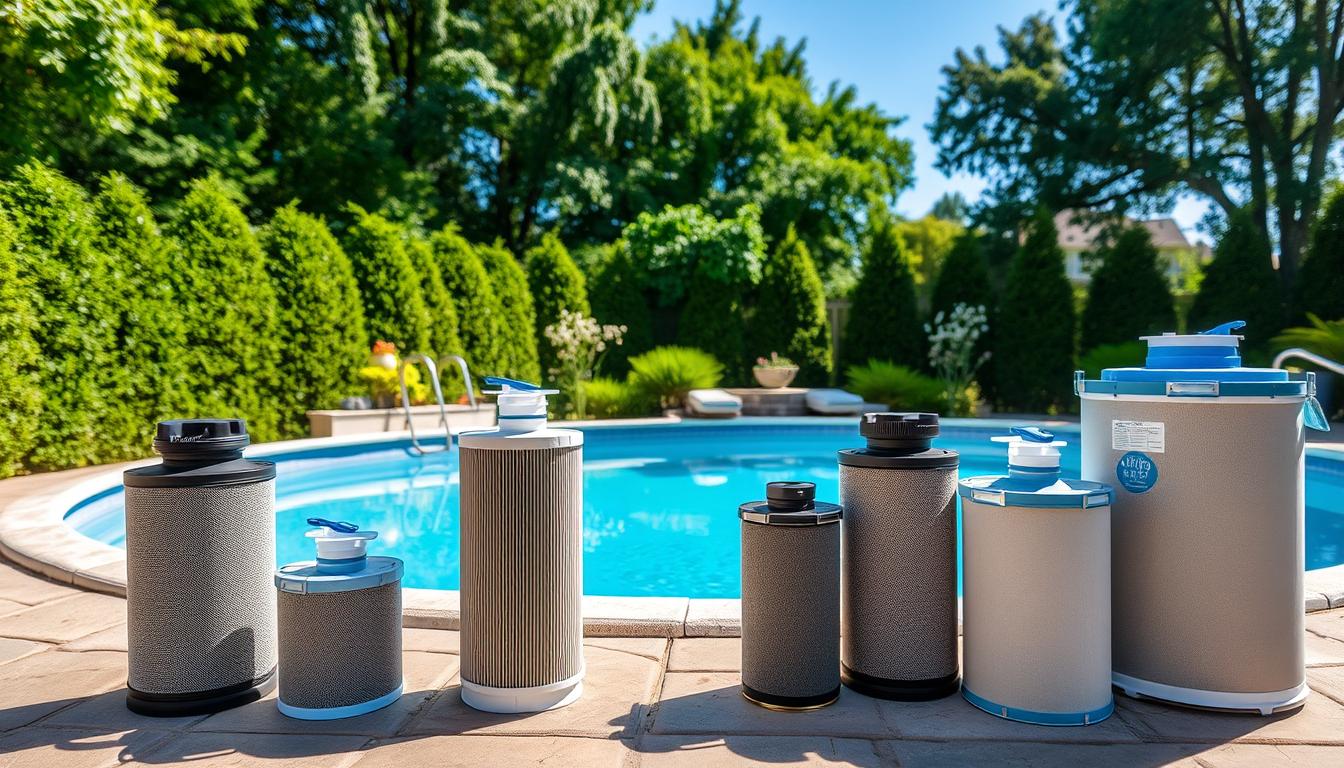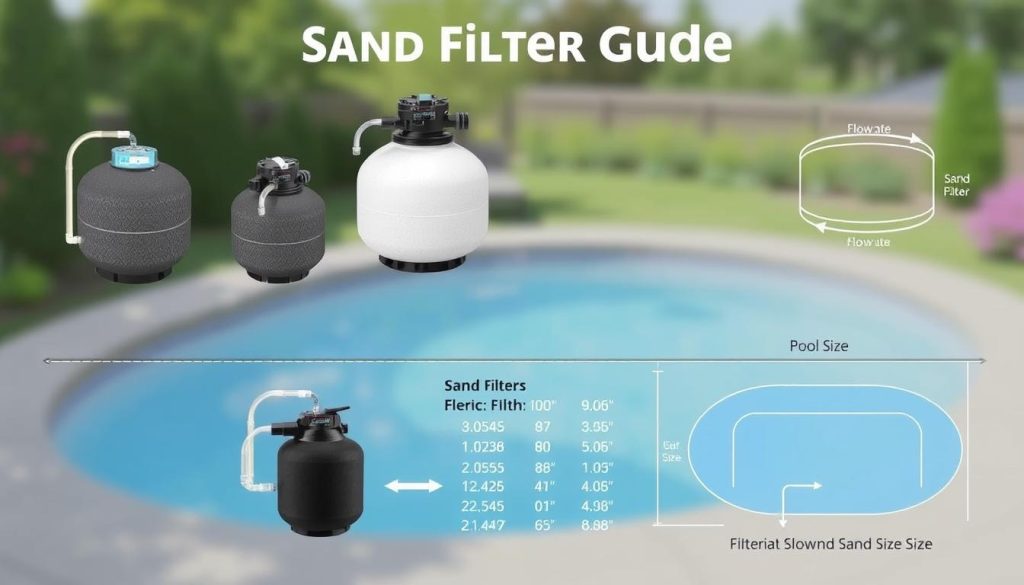
Imagine a hot summer day. You’re ready to jump into your above ground pool. But the water looks cloudy and unappealing. The problem? A wrongly sized sand filter. Picking the right filter size is vital for clean water and efficient equipment.
Correct filter sizing is crucial. A small filter can cause poor circulation. This lets debris and algae build up. A large filter can overwork your equipment and waste energy. Both situations can lead to costly problems.
Most above ground pools are similar in shape and size. This makes finding the right sand filter easier. Water capacity and pump flow rate are key factors. Your filter pump should clean all pool water in six hours.
Match the system flow rate to the pump package value. This ensures better filtration and a cleaner pool. With the right filter, you’ll enjoy crystal-clear water all summer long.
Factors to Consider When Selecting a Sand Filter
Selecting the right sand filter for your above ground pool is crucial. It ensures optimal performance and water clarity. Consider your pool’s needs to choose a filter that maintains a clean swimming environment.
Pool Size and Water Capacity
Your pool’s size and water capacity determine the appropriate sand filter size. Larger pools need filters with higher capacities for effective water cleaning.
Calculate your pool’s volume by multiplying length, width, and average depth in feet. Then multiply by 7.5 to convert to gallons.
For example, a 24x12x4 foot pool holds about 8,640 gallons. Knowing this helps you pick a filter with the right capacity.
Pump Flow Rate and Turnover Time
Your pool pump’s flow rate is key when choosing a sand filter. It’s measured in gallons per minute (GPM) and determines water circulation speed.
Choose a filter with a slightly higher flow rate than your pump’s maximum. This prevents bottlenecking and ensures efficient circulation.
Aim for a 6-8 hour turnover time. This means the filter should process all pool water within that timeframe.
Debris Load and Maintenance Requirements
Consider the type and amount of debris entering your pool when selecting a filter. Pools near trees need larger capacity filters to remove bigger particles.
For pools collecting fine particles, choose a filter with finer filtration media. Think about maintenance needs, like cleaning frequency and replacement part costs.
Pick a filter that matches your needs, such as eco-friendliness or compatibility with other pool equipment.
| Filter Type | Filtration Capabilities |
|---|---|
| Sand Filters | Trap particles as small as 20-30 microns |
| Cartridge Filters | Trap particles as small as 10-20 microns |
| DE Filters | Remove particles from 3-5 microns |
Evaluate your pool’s size, water capacity, pump flow rate, and debris load. Consider maintenance needs too. This helps you choose the best sand filter for your above ground pool.
Calculating the Ideal Sand Filter Size for Your Above Ground Pool
Picking the right sand filter size is key for clean pool water. Our guide helps you find the perfect sand filter requirements for pools. Let’s explore how to calculate the ideal filter size.

Determining Pool Volume
First, figure out your pool’s water capacity. If you don’t have the packaging, estimate 90% of the pool’s volume. For rectangular pools, use this formula:
Length x Width x Average Depth x 1000 = Volume (litres)
With the volume, check a pool equipment sizing guide for the right filter size. This guide uses your pool’s measurements to suggest the best fit.
Matching Filter Flow Rate to Pump Capacity
Next, make sure your sand filter’s flow rate matches your pump’s capacity. This prevents circulation issues and keeps filtration efficient. Here’s a quick look at common filter types:
| Filter Type | Filtration Capacity | Maintenance |
|---|---|---|
| Sand Filters | Good | Silica sand lasts up to 3 years |
| Cartridge Filters | Excellent (2x more than sand) | Replace cartridges every 2 weeks |
| DE Filters | Superior | Requires frequent backwashing |
Use a sand filter flow rate calculator to find the best flow rate. A higher flow rate can clean better, but balance it with your pool size.
Ensuring Optimal Turnover Time
Turnover time is how long it takes to filter all your pool water. Most pools need 6-8 hours for good filtration. To find the turnover rate, use this pool filter gpm calculation:
Pool Volume (gallons) ÷ Pump Flow Rate (gpm) ÷ 60 = Turnover Time (hours)
Choose a sand filter with the right flow rate for proper turnover. This keeps your pool clean and saves energy and maintenance time.
Climate, debris, and pool use can affect your ideal filter size. Ask a pro or check a pool equipment sizing guide for the proper sand filter size.
These tips help you pick the best sand filter for your above ground pool. You’ll enjoy clean water and easy upkeep all season long.
What Size Sand Filter for Above Ground Pool: Common Recommendations
Choosing the right sand filter size for your above ground pool is crucial. Most standard pools need a sand filter with a 1,500 gallons per hour (GPH) flow rate. This rate filters the entire pool within six hours, keeping the water crystal-clear.
Match your sand filter to your pump’s flow rate for optimal performance. Check your pump’s specifications to find its flow rate. Then, select a sand filter that can handle an equal or higher rate.
Balance is key when selecting a sand filter size. Oversized filters can be inefficient and waste energy. Undersized filters may struggle to keep the water clean. Consider your pool’s specific needs when making your choice.
Regular maintenance extends your sand filter’s lifespan. Backwash and rinse the filter to remove debris. Replace the sand every 2 to 3 years, depending on your location and air quality.
By choosing the right size and maintaining your sand filter, you’ll enjoy clean water for years. Your above ground pool will be a refreshing oasis all summer long.







